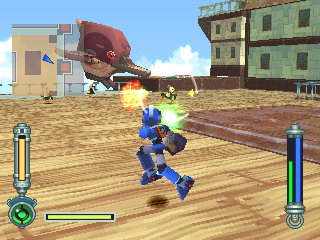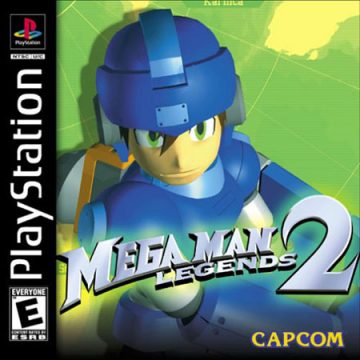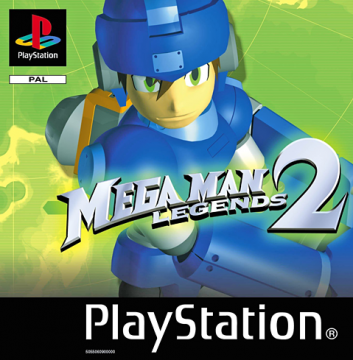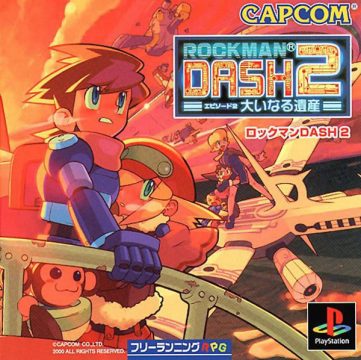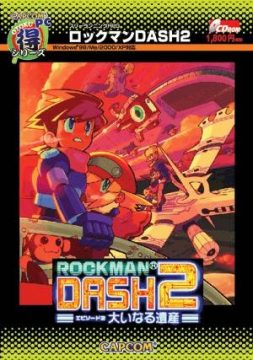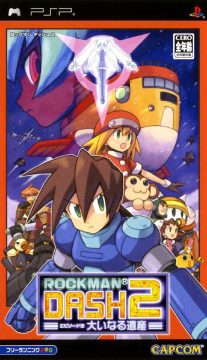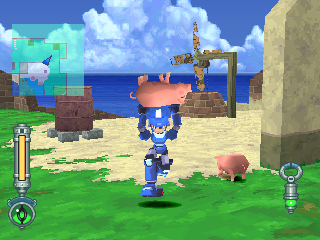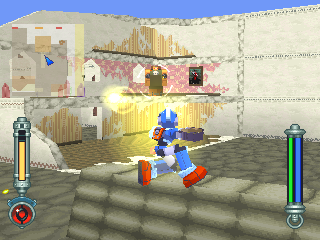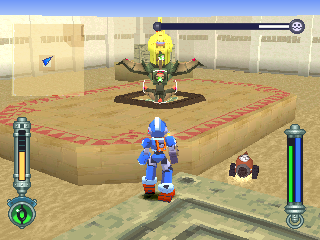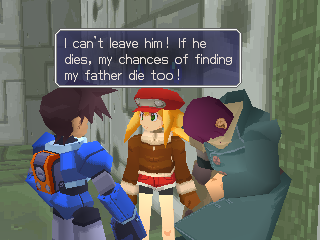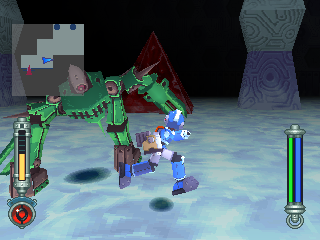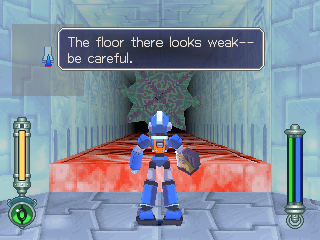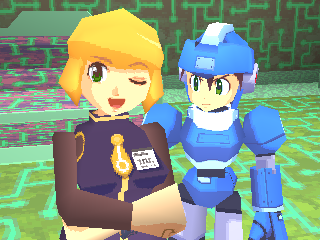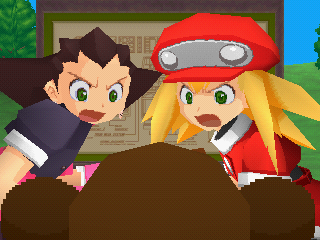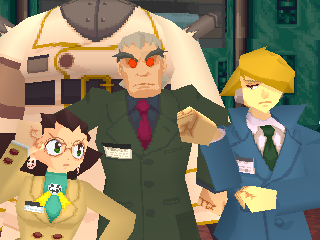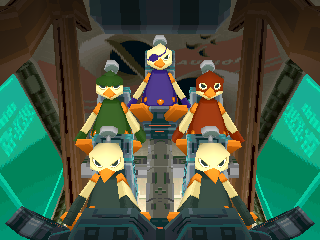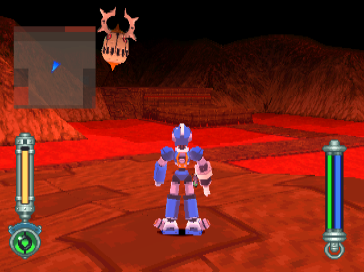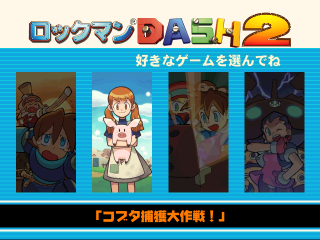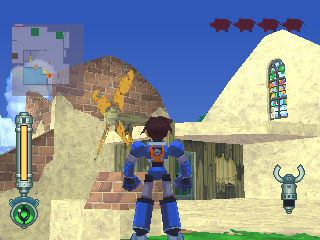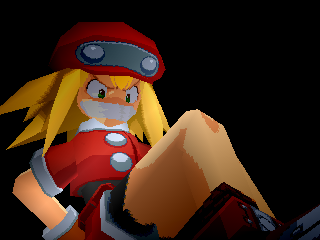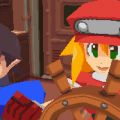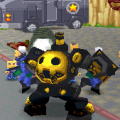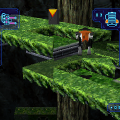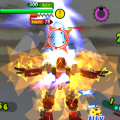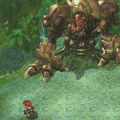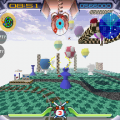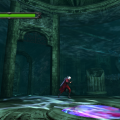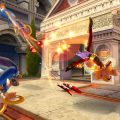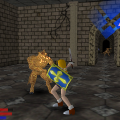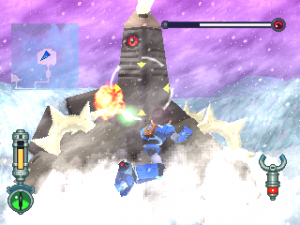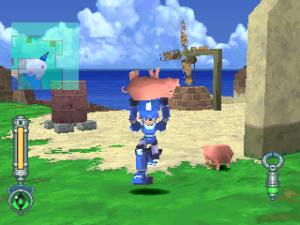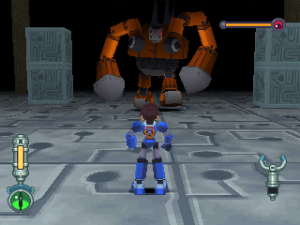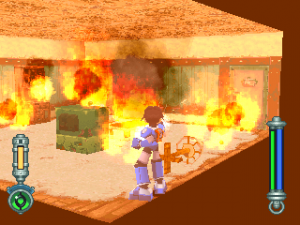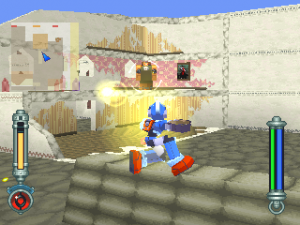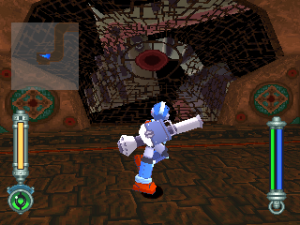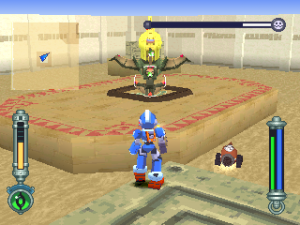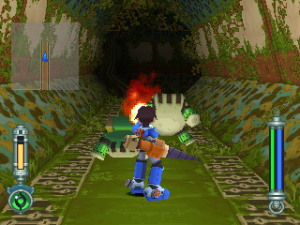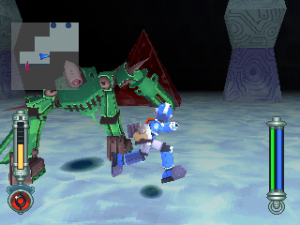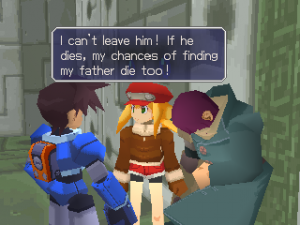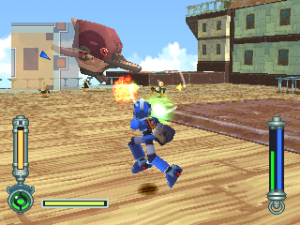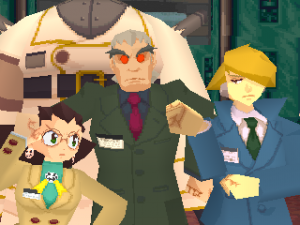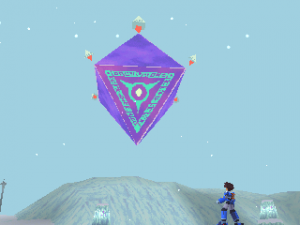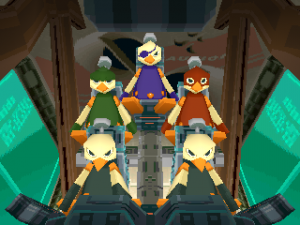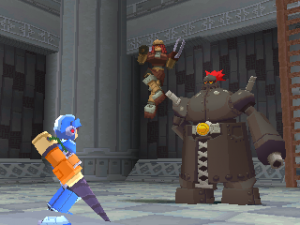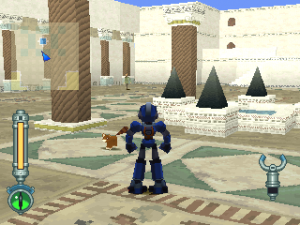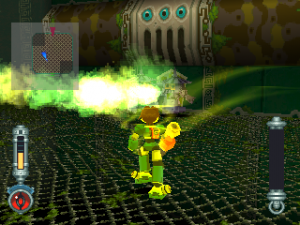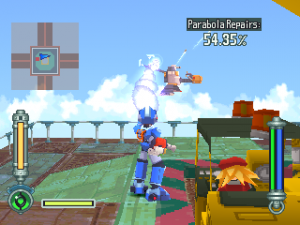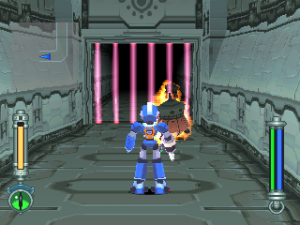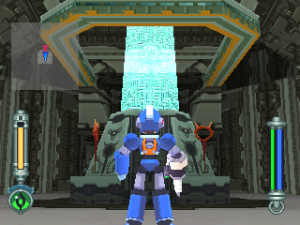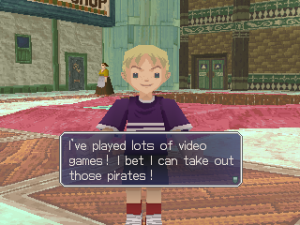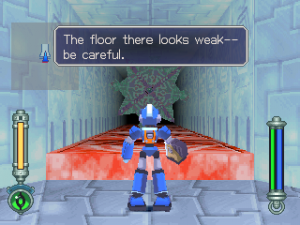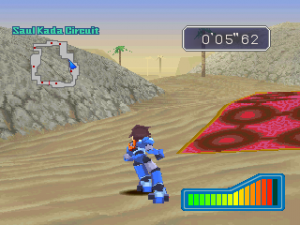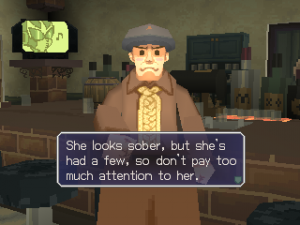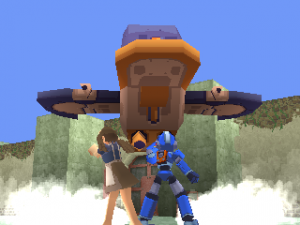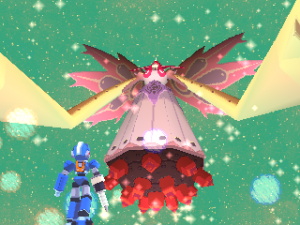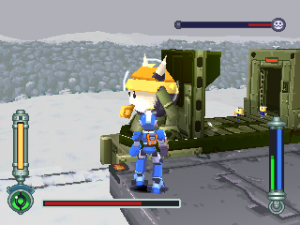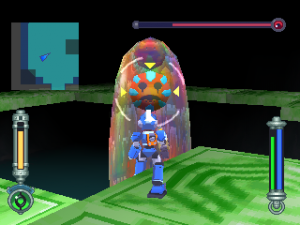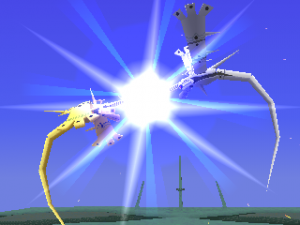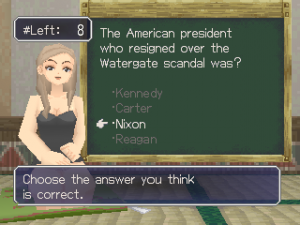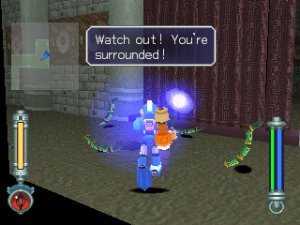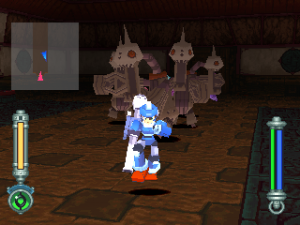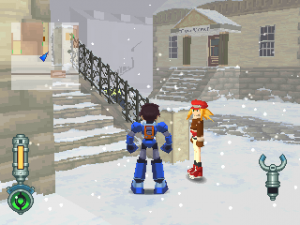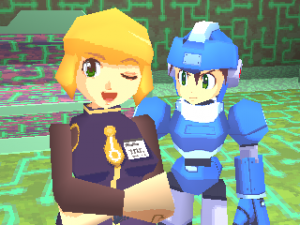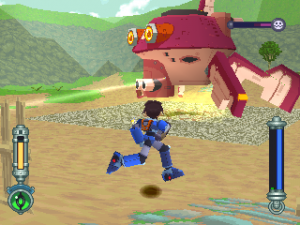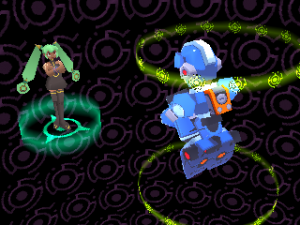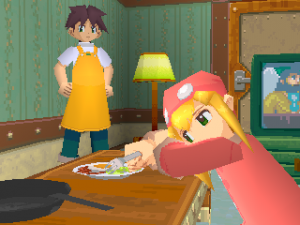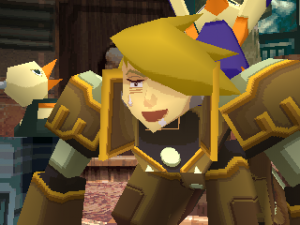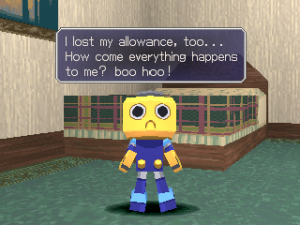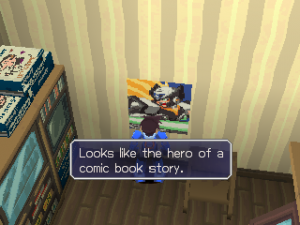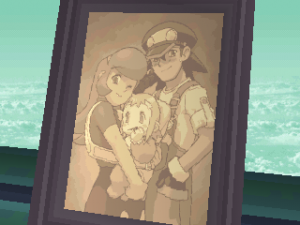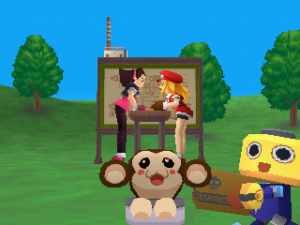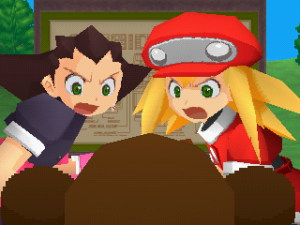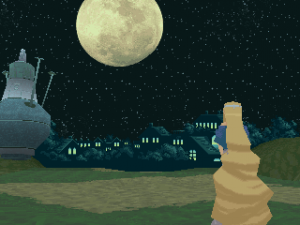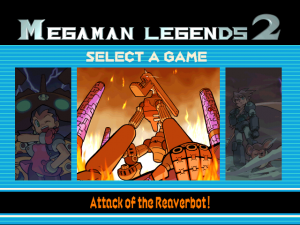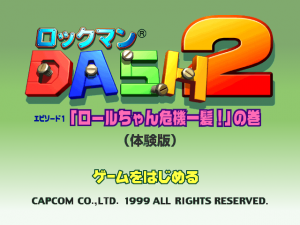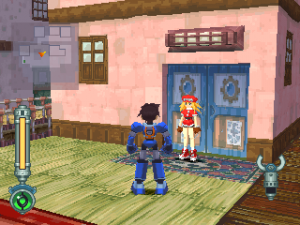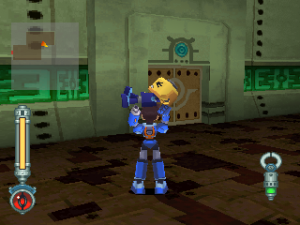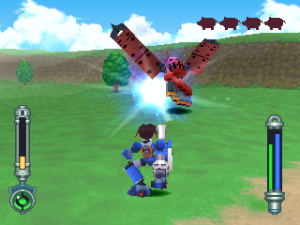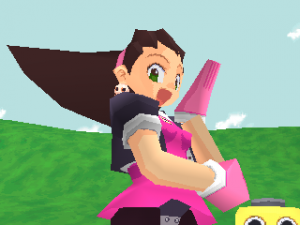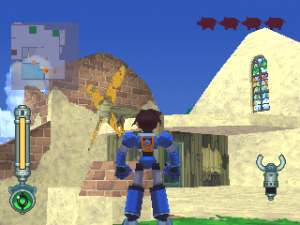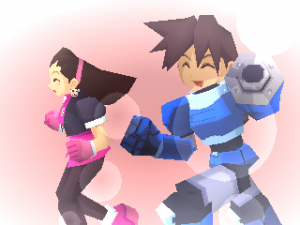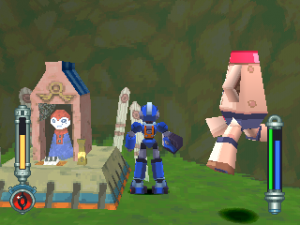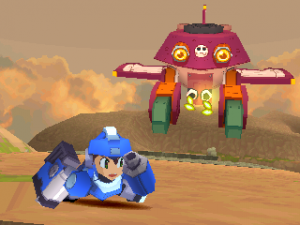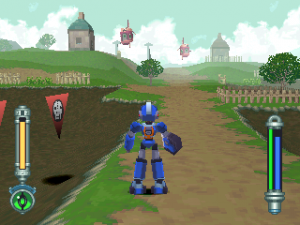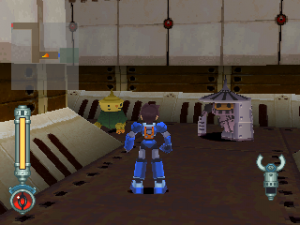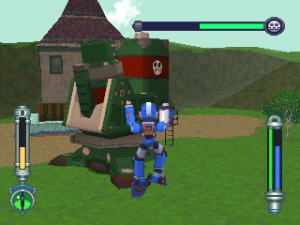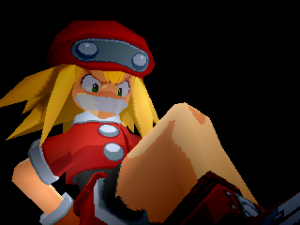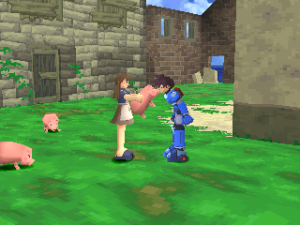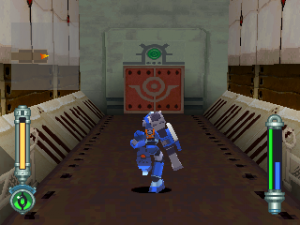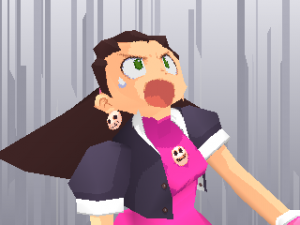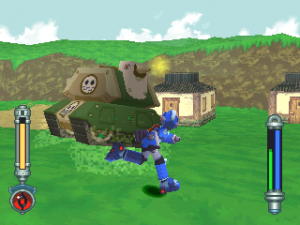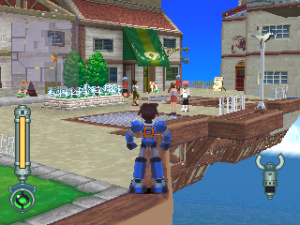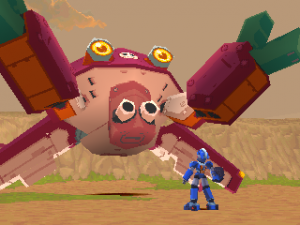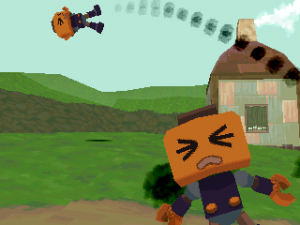- Mega Man Legends
- Misadventures of Tron Bonne, The
- Mega Man Legends 2
The numbered sequel marks a return to form as the player is put back into Mega Man Volnutt’s boots. With great strides made to improve the engine and mechanics, the next game in the more adventurous Mega Man series set out to be a bigger quest spread about multiple islands. With six main stops, a handful of towns, various biomes, and themed ruins, Legends 2 earnestly seeks to broaden its reach and build upon its world and beyond with multiple plot threads interwoven.
The game begins with everyone in a bit of a downturn. Tensions have grown high, a televised struggle on Von Bluecher’s Sulphur-Bottom has caused it to crash-land on Forbidden Island, leaving Barrell Caskett and all the other occupants stuck there; the Bonnes have run into money problems once again; Roll is feeling down thinking about her missing parents; all of Mega Man’s gear from the first game had to be sold to make repairs; and a fire has just broke out in the Flutter’s kitchen after Data tries to cook a meal on his own. Spirits are low from the offset, with the first chapter taking place on a bleak snowy island. The trip there only brings about bittersweet moods and a transport to dive into a blizzard-vortex danger zone only to once again awaken a destroyer. Hey, nobody said a Digger’s life was all sunshine.
There is a lot more to take in that’s changed from the first game. In far literal sense the intro before the title screen lasts over 8 minutes to set the stage of the Sulphur-Bottom news report and catastrophe; a sign of the increased use of (thankfully skippable) cutscenes laden throughout the game. The leap in graphical fidelity is apparent from the get-go. Aside from the more ambitious animations and framing for the narrative portions, the graphics have gotten a significant boost in character poly count, texture work, and Gouraud shading. In fact, everyone returning from the last titles looks completely redrawn in the engine makeover. Other additional effects are included, such as falling snow, screen ripples while underwater and in superheated rooms, and that wavy mirage distortion while hiking through the desert. The improved control scheme and camera controls first tested in Misadventures and the Episode 1 demo is ported over for Legends 2; with plenty of optional settings to tinker with, up to and including a means of playing pure digital. Mega Man received a shift in English voice cast in Legends 2. Corey Sevier, a Canadian teen actor at the time, was unable to keep the same consistent pitch from the first game with the progression of adulthood. In his place, Susan Roman, who filled the dubbed role of Mayor Amelia in the first game, took over Volnutt’s English portrayal, sounding an awful lot like her provided voice for the DiC-era Sailor Jupiter. The main menu even includes a quick optional Tutorial that places players in a tiny set of rooms to get acclimated with the controls.
Being used to the controls from the onset is important as the game wastes no time throwing Volnutt into the literal fire on the first mission. Armed with the mostly useless Aqua Blaster, Mega Man needs to dowse the flames in the Flutter and reach to snuff out its source in the kitchen. The use of lock-on is vital to spray clear the fires or put out the blazing sparks igniting Data before he can harm you in his panicked stampede. Though this initial mission can’t be failed, the time spent up to and including Roll finally fixing the sprinkler system can put a much larger dent in your wallet for the repairs.
Oh, about that wallet problem. The sequel has plenty more money sinks and items to purchase on top of the boost in weapon upgrade costs. There’s also been some staggering inflation between outings as returning sub weapons now cost far more to upgrade. The near million Zenny to fully pimp out that Shining Laser attachment in the first game has now skyrocketed to tens of millions. Naturally, nothing gained on Kattleox Island is kept on hand (aside from the Jump Springs, it seems), with Roll giving an in-universe excuse of having to pawn all that gear for Flutter repairs. This ludicrous price hike aggravates the grinding issue the series has had to an astounding level, one that is only alleviated by a trick in an early optional ruin to farm Refractors from an exploitable large foe at a speedy clip.
The driving force of the plot falls back on an RPG standby. It’s a race to collect MacGuffins within themed dungeons in order to save/destroy the world. The four keys are linked to what is told by Geetz the means to unlock the coveted Mother Lode. Surely he and his near-catatonic partner Sera are to be fully trusted, and these keys are in NO WAY linked to any method of annihilating an entire species from the planet. Either way, Mega Man has to find the keys first before the precarious allegiance of air pirates nabs them first. This mad scramble for plot coupons does come off more cliche, but Legends 2 avoids some of the pitfalls of certain tropes related to this sort of quest its counterparts like Skies of Arcadia. Never is Volnutt wrenched of his hard-earned collectibles from simple deception nor has to trade them all away at the last minute to saved a captured damsel near the end. There isn’t a particular explanation as to why the ruins now mimic elemental overtones straight out of a Zelda title, however.
Once you get word of a potential site where one of the keys may lie, another island becomes open for the Flutter to land. Each new area unlocked varies with differing biomes to span over. The frozen continent of Calinca and the Forbidden Island at the beginning of the game are contrasted with the tropical Manda Island and arid Saul Kada Island, only to round off with the temperate plains covered Calbania Island and the miniscule Nino Island smack dab in the middle of the ocean. Each of the four major ruins housing the keys match the theme of their respective land and the city built around the entrances. Thus Volnutt must spelunk caverns overgrown with vegetation, Romanesque temple sunken underwater, a Turkish tomb carved by magma chambers, and a crystallized frozen catacomb accessed by, of all places, a church.
The diverse island and dungeon scapes serve an assortment of flavors for 32-bit backdrops. The dev team went out of their way to fix the issue of the underground corridors looking too much like simple palette swapped walls. Granted, the optional Digger Class ruins repeat the same aesthetics, but the main “temples” throw in their own flavor of design. The jungle, water, volcano, and ice themes aren’t exactly genre-busting, but the gimmicks within to contend with and solve as easy to mentally grasp and serve to keep the different catacombs from being alternating window dressing. Many of the Reaverbots mimic animals that would inhabit the real-life regions the temples are modeled after, like hopping frog bots among the vine-covered walls and mammoth-like tanks patrolling the frozen ice. The spread of various locales is assisted with the expanded soundtrack, dropping the atmospheric loops for distinct motifs. Keeping with the Zelda inspiration, each of the main ruins have little computers that download map and treasure chest data. And what RPG dungeon wouldn’t be complete with traps aplenty complete with mimic treasure chests? With legs!
However, all the boost in graphics come at a cost. Slowdown becomes an issue once the screen becomes too busy with polygons or effects being loaded. Walking around the center of the expansive Yosyonke City with the snow flurries flying and the frame rate dips heavily. Fog effects do try to alleviate the problem, but the variation of polygon lighting is far from smooth, causing pop-in and noticeable color shifting. Thankfully it doesn’t reach Turok-level pea soup fog, but the dungeons do come off as especially darker. The better texture work also makes the floating point inaccuracy of the PlayStation hardware far more apparent, especially with the added scene transitions of opening doors. There are more residential interiors to explore, but many rooms tend to repeat the same design with only the inhabitants changed around. Even the ruins fall into this trap, having some repeated hallways and treasure troves padding their length out.
Mega Man’s arsenal of secondary weapons have been pruned and shifted around. Many of the mine and grenade arms have been dropped in favor of superior replacements. The Ground Crawler rolls bombs with better precision rather than planted stationary explosives, and the Crusher lobs potent electromagnetic bombs that don’t merely bounce about aimlessly. The Buster Cannon improves on the flaws of the slow Powered Buster, allowing for a better rate of fire by far. The Blade Arm has been given a far longer reach when upgraded, making it far more useful. The Hyper Shell’s concussive boom scatter is a fantastic update to the old Spread Buster, even at the cost of low round stock. On the flipside, the super-powered Shining Laser was mildly nerfed from being as über as it used to be, although it’s still the best Special Weapon in terms of raw power. Naturally, the selection is still far from balanced, leaving some weapons more practical on the field. Given the greater scope of aerial threats and turret-like dog-fighting from afar, the Homing Missile with its potential for unlimited ammo is the go-to best boss battle sidearm. For those who like to cheat, the standard Buster has an exploit that negates the need for Rapid and Energy-boosting units. Holding Fire and tapping forward makes shots machine gun from Mega Man, making quick work of foes.
A lot of the broken bits and junk parts needed for weapons and accessories aren’t as concealed as they used to be. Most of the important pieces are sold in shops while those in the wild are contained only in chests and not stashed inside holes in the walls. What hidden holes in walls there are in the ruins house troves of easily replaceable Zenny and are more conspicuous with a polygonal indent rather than being a missable texture difference. Even gifts for Roll and items exclusive for the Flutter are only a trip to the market away. Moreover, Roll gives hints on which parts go together and outwardly states whether she can make something with what you have rather than blindly attempting any creation.
The latest means of equipment are various shoes to attach to Volnutt. No longer are Jet Skates the only optional foot upgrade, as several chips that can be given to Roll for special footwear doled out conveniently in time to the upcoming threat or annoyance within a lair. While very pricey or easily overlooked, these shoes are worth the trouble making as status ailments have been introduced. While Mega Man no longer has to worry about his Life Shield breaking, he can suffer lingering damage from fire or extreme cold, as well as become paralyzed from electricity. Far more infuriating of an ailment is receiving an Energy Leakage, which prevents Volnutt from firing any weapon as well as drain his Special Energy within seconds if he doesn’t unequip his special weaponry immediately. Most of these conditions are given via enemy attacks or damaging floor panels, which the latter can be remedied with certain shoes. Added safeguards can be purchased to form barriers against flame strike or electrical surges. Of course the kicks Roll can suit you up with aren’t just for prevention. Cleated Shoes keep you from slipping on ice and Hydrojets allow Jet Skate power underwater.
Besides the overall Easy/Hard/Very Hard difficulties that can be unlocked after playthroughs, players can up the challenge and rewards on Normal difficulty with Digger License Tests at the Guildmaster’s office. Mega Man will start at Class B and can raise it to Class A and S after passing the allotted timed exams through a mini dungeon with zero upgrades. Obtaining Class S is maddeningly tough without precise movement, Lifter usage, or abusing the tap-walking rapid shot exploit. Passing these exams are required to gain access into the optional ruins assigned by Class ranking, each more dangerous than the last. These extra asides are excellent for earning high-price Refractors and exclusive parts to hand to Roll. The placement of enemies inside also change each time you go down to break the monotony. Passing the tests to open these ruins is only necessary in Normal Mode, as Hard Mode starts the player off as an S-Class, with Easy and Very Hard’s respective Class C and Class SS letting you in for free. Each step up on the ranking boosts the defenses of enemies, but also their Zenny drops (except for C and SS which inversely quadruples or halves the value of all Zenny respectively to add to the breezy or extreme difficulties).
The towns you visit, while more numerous than the first game’s sole city, don’t seem as robust. The lowered total of NPCs roaming around and additional sidequests to perform for them reduces these villas to basic respites to purchase new gear and garner a few flavor texts. The folks you do come across are for the most part unique in designs rather than using the RPG staple of having 6 generic age and gender models repeated. However, the majority of these people rarely develop past their initial lines they dish out to the player. Take one NPC that arrives in Yosyonke once freed from her frozen state from the Forbidden Island: a punky lilac-haired dark skinned lady in a red bodysuit, a character model seen nowhere else, merely standing in a graveyard shocked to see her own tombstone with no added development throughout the rest of the story. Ironically, with more discrete towns to visit and faces to see, the lack of a centralized city hub to frequently pass through and see evolve makes the world seem smaller. Nothing illustrates this point of the hollowness of the beautiful civilized vistas better than the shutout of entire sections of the arid Kimotoma City. With a festival cancelled thanks to a Bonne invasion (a Japanese-style outdoor festival no less, complete with takoyaki stands planned), a fight through a large portion of the walled city serve only as a pathway to mow down Servbots. This includes a row of unique empty homes, a storage facility, and a marketplace used only for a search for a key that only star in a blink-and-miss-it assault to a boss battle. Afterwards, Kimotoma is rather barren for its size with both shops placed in demolished building exteriors. No festival gets to take place, nor do majority of the boroughs used for skirmishes ever refill or become allowed open to the player again. All that work and assets for what will pass by in one outing.
Plenty of the new Reaverbots encounters are frustrating to deal with. Some enjoy playing keep-away from Volnutt’s shots, though the skirted doll-like Sukaritts do so in silent creepy fashion, complete with the haunting giggle should Refractors be involved. They can be avoided, but Hangekals are literal keys that need to be chased down and nabbed with other tiny Reaverbots popping in to play defense. Amistals are simple floating spheres, but spit out tiny explosive spores that home in on Mega Man by the dozens. Far more aggravating are Shubafun traps that emerge from the floor in later dungeons that latch onto Volnutt’s feet to drain health, and they can’t be spotted until it’s too late. Add to some of the prior tricky foes from the first game and even the simplest of battles become chores.
The worst gameplay section, like so many video games, involves diving underwater. The tedium and dread Ocarina of Time‘s Water Temple invokes is nothing compared to the anguish of Nino Ruins. Like many of the hated Zelda dungeons, water levels need to be raised and lowered on a floor-by-floor basis to allow buoyancy to leap over tall structures and high alcoves via relatively harmless manta-ray-like Mandomantal Reaverbots. The problem lies with movement underwater; Mega Man maneuvers more sluggishly in the flooded floors, and his jumps becoming floatier. Raised water levels also make more dangerous enemies emerge and make the already annoying enemies even more challenging to contend with due to Volnutt’s added restrictions. The problem is that the water is needed to lift heavy blocks for platforms and to move onto switches to turn off currents. Coupled with the hardware chugging to render the water rippling effects, the slog of backtracking to elevators to change water levels, and having to ride on a swimming Reaverbot on its own wandering path for a crucial key to open a door, this dungeon halfway through the game becomes a nightmare of patience. To add to the repetitive nature, Mega Man doesn’t teleport out of the dungeon after acquiring the Key and beating the boss guarding it like the other ruins do; instead, he has to backtrack all the way to the entrance just for a “Gotcha!” rematch. The Hydrojet Shoes Roll can construct only bring minimal reprieve by allowing Mega Man to skate under water for some needed speed. The underwater torture extends beyond the Nino Ruins with the Kimotoma Caverns, a dungeon permanently trapped submerged under water (underneath a barren desert, mind you). Fortunately, the latter dungeon is an optional sidequest with minimal rewards aside from a Refractor worth a large sum of Zenny, and obtaining access involves earning a Class S Digger’s License.
As jam-packed as the plot is, it moves at a brisk pace. Mega Man and Roll are constantly on the move, hopping from island to island, running into plenty of new and returning thieves of the Air Pirate Alliance vying for the Keys. The Bonnes and Boss Reaverbots continue being pesky obstructions to topple, while Glyde and his Birdbots get to have their share having to tango with the blue boy. Newcomers Bola and Klaymoor, sadly, come of as mid-bosses only, seeing how they battle mano e mano and not with squadrons of ships nor hulking mechs. At the very least, the boss encounters have more variety in their tactics and no longer distill into the tried-and-true circle-strafe affairs the previous game fell into a lot. The fight with Teisel’s serpentine mech even changes dramatically depending on how Mega Man plays it out, making it either a timed snipe shoot or spastic game of whack-a-mole. Oh, and the final stretch throws in a gauntlet of Reaverbot rematches in classic Mega Man fashion.
Let’s not forget the story itself. While the main thrust is the Key hunt, the exposition dumps expound heavily on the greater scope hinted near the end of Legends. The major moments leading up to the Mother Units are bookended with dropships heading into the hearts of darkness. The grey area of whether the fate of Carbons should follow the original or revised orders is thrown out, though ultimately the answer is going with the Master’s final wishes. There is also the tragedy of the Mother Units stuck following their code, Roll’s realization of her parents’ curren states, even Elysium’s cold, sterile dread of what it once was. More of the striking moments in the game are through the environment or with the descriptions Mega Man states observing the world and objects. Finding the crashed plane, the frozen people once on board, the loneliness of the passed parents in the disheveled home of Shu and her trying to mother her siblings, even the empty village of the lost humans on Elysium tells so much.
At least the series’ sense of humor is still intact. The Bonnes are always a hoot, as usual. One fight with Tron ending with an off-screen humiliating wardrobe malfunction is only the tip of the lunacy. Raiding the fortress the Birdbots have liberated, you can find amongst rubble from a skirmish their food stash: Fried Chicken. Klaymoor’s rematch has to be cut short due to throwing his back out, and Bola has to teleport him away as he tosses out excuses. The legions of Servbots again stake out the most innocent of places, or just announce how hopelessly lost or inept they are. Honestly, any point with the pirates helps alleviate the tension. That and the countless facts about cacti Mega Man will spout from the same pot model cropped up in the repeating rooms. It must be since a cactus was one of the few items he had in his room in the first game.
Once again, Mega Man can act as sinister or as generous as he pleases. While there isn’t quite an overt means to run rogue like stealing money (although tossing someone off a high platform would seem more murderous if the person didn’t cartoonishly return unscathed later), animal abuse is still available and uncensored this time around, allowing for as much protested-by-PETA actions to indulge in. There also carries more perks and drawbacks to playing dirty than mere hushed speech behind doors and news reports. Some NPCs grow more hostile and untrustworthy of Mega Man when he’s evil, jacking up prices for goods and closing you off from potential sidequests until you clean up your act. Completionists will need to play both sides of morality however, as only a bad Mega Man can deal trade with a shifty merchant for exclusive items, one of which is needed for a special weapon while the others can be hawked for a fine price. Fortunately, salvation is gained easily, though costly, with donations handed to the church. A good Mega Man gives off a bright glow off his textures and receives discounts at shops the world over. It’s still easy to play nice, as doing the main quest once again always does wonders for your reputation.
Parallel to this moral system is Roll’s affection towards Mega Man personally. While many of the same bad deeds that color your armor are reflected within pages of her diary, there are personal strikes your Spotter can administer to you for acting naughty — figuratively and literally. Being mean to Roll when she follows you, such as blasting pellets at her or picking her up causes her to interject with a mighty slap that will floor Volnutt and shave off his health; it’s possible to even get a deadly Game Over from lifting up your partner enough times. Roll will also take great offense if you shoot the Flutter down. Being a black-suited warrior comes with it a heavy price: her disappointment in you. If that isn’t enough, dismissing her when she gives you a concerned talking-to will cause her to raise her own upgrade prices thanks to her tools “breaking”. Fortunately she can be won back over with some gifts like a stuffed animal. Showering Roll in enough gifts and additions to the Flutter will leave her loving Mega Man no matter what, so you can at least have one person rooting for you while you return to piggy-punting. Amusingly, fully completing the renovations and tokens of affection is how the player unlocks another triumphant “run-in” with Roll, this time in the bath.
Oddly enough, Legends 2 received the equivalent “all-ages” rating worldwide despite a segment of partial nudity. No, it’s not the bathing blonde, but Sera awakening on Forbidden Island with nothing on but her blank stare. Granted, her model is still fairly blocky, and generally received the Barbie doll smooth design, but her initial appearance is with a conspicuous shot of the texture signifying her butt crack. On a humorous note, this nude model is available in the debug room, where the tester can place Sera in various silly poses.
The localization of Legends 2 isn’t as drastic as the first title. As per the norm, a J-pop song is played over the end credits in the Japanese version. The song “Naite Ii yo”, or “It’s Alright to Cry”, sung by Fumina Hara, was replaced overseas with an in-house instrumental. The original PS1 Japanese ending credits also showcased ten fan illustrations in all of their crayon and colored pencil glory. The Japanese version even had the full names engraved on the bedrooms in the Flutter instead of mere initials of “M”, “R”, and “B”. The questions given during the Pokte quizzes are different between Japanese and International releases, along with updates with newer references to Capcom releases in the PSP version. An earlier debug edition of the English version was posted on the internet. While the voice work hadn’t been implemented, the early script does have a few lines that have been altered in the final print, such as the one kid on Nino Island specifically mentioned honing his fighting skills on “Resident Evil” than just “video games” (perhaps the very same “Resident Evil 43” cart you can purchase at a store in the game world). A PC port was created, although it never left the Asian markets. Unfortunately, it suffered compromises on the sound quality and doesn’t play as nice with modern OSes like the first game’s port. The later PSP port does come with two major improvements. A lot of the outrageously expensive costs for weapon upgrades are slashed to reasonable prices, and the terrible slow speed of the underwater segments are curtailed with the faster processor. The full map of a current area is easily jumped to with the Select button as well, as the Start Button returns to being the Menu Screen instead of a mere Pause. It also adds subtitles to cutscenes like the first PSP port did, as well as includes the Japanese “Episode 1” demo. Finally, early April 2016 brought the sequel to PSN Store, thus finally concluding the series as-is to have digital copies available for cheap.
There are many improvements that make Legends 2 a better game than the first. However, with the darker themes, limit-pushing engine, and loss of the more idyllic nature, reception of the overall product is a lot more mixed. Many of the problems are typical of the 2nd of a trilogy, having the action at its most dire before the third act. This leads to the most remembered part and the sore spot for the fans as the cliffhanger ending is never resolved. Mega Man, Yuna in Matilda’s body, Sera in Yuna’s body, are all trapped up on Elysium with no means of getting home. Despite Tron and Roll working on a rocket, the butting of minds is keeping their efforts grounded. A decade-long hiatus of a sequel kept those wanting closure salivating for news of Legends 3. Oh, how sour that became…
Rockman DASH 2 – Episode 1: Roll-chan Kiki Ippatsu! (ロックマンDASH2 エピソード1 ロールちゃん危機一髪!) – PlayStation, PSP (1999)
With the true sequel to the first Legends still nearly a year away, Tron ni Kobun had a bonus disc containing a demo with four missions for Mega Man to run around in to curtail the wait. The demo disc itself is treated as a prequel/prologue chapter before the events of Legends 2, with most of the gameplay focusing on the new and improved elements for the upcoming sequel. Considering that some of the engine overhauls aren’t even integrated within the game it was packaged with, like proper texture shading, was a testament to what the “A”-team had kept busy with during development.
The first mission even serves as a testing ground to try out the tightened controls, starting in the floating villa of the near-empty Ruro Town to chat with Data and Barrell before Roll teaches you the ropes in Ruro’s Ruins with a handful of Servbots as target practice. This is where Mega Man can learn about the new grab mechanic as those cute bots can be lifted and carried around and hurled. The next mission puts that grabbing claw arm to better use as Volnutt heads to Calbania Island to round up 4 missing pigs for Shu for a nice smooching reward. The 3rd mission is a simple dungeon run within the demo-exclusive Rido Ruins that concludes with a boss battle that will reappear in the final game early on.
Of course, this all culminates in the star mission and the reason for the demo’s subtitle, which translates to “Roll’s Critical Moment!”. Tron has kidnapped Roll and tied her up in a box outside of a village for the sole purpose of extorting Mega Man to join the Bonnes’ ranks. The scene plays out with overblown narration and cutscenes, along with the choice to give in to Tron’s demands for a humorous glimpse of what might be with Mega Man on Tron’s side. Sadly, despite the illusion of choice, Mega Man refuses, so things go the hard way of battling through a gauntlet of Servbot-piloted tanks and ships to collect keys to pass through gates to reach Roll. This leads up to a crab-bot battle against Tron that finished with her defeat and her hasty retreat, but not without a sprinkling of her unrequited crush on Volnutt. Plus the rescue attempt ends with a shaggy-dog finale that Data already saved Roll during this time.
Capcom was hard at work improving the stiff controls of the first game, along with some gameplay tweaks to fix little annoyances. Analog support has been added to allow twin stick movement with a Dual Shock, as well as on-the-fly camera turning and pivoting. Mega Man can now also move and strafe while locked onto a target, no longer forcing him to plant his feet in place for precision shots. The target icon itself has been given a facelift to make it stand out better in the heat of battle, with a subtle color distinction for the arrows: red if the enemy is out of range of your blaster and yellow if they’re clear for blasting. The warning alarm that chimes in when foes are nearby is no longer as loud and startling either. Oh yeah, and rumble support is now available. Special weapons are also handed to test out on the missions along with a helmet to equip, although it’s not stated outright. The player has to hop into the menu and manually switch to them.
While the demo serves its purpose of granting a taste of what was to come, this disc is a gem of exclusive content — even if it’s a fraction the size of any full release. The only area to make a return in the full game was the sectioned-off segment of Calbania Island, leaving plenty of fresh content for players to experience within the demo even if they’ve completed the actual sequel. Considering how dense and detailed Ruro Town is just as a glorified menu to reach the training ruins, it’s a shame it never got fleshed out for the effort put into building it. It is also surprising how much more of Pokte Village is explored and shown in this demo compared to revisiting the place in the actual game; what ended up a quick boss battle stop in an enclosed compact space is traversed here through sprawling plains, crop fields, twists and turns through canyon cliffsides and valleys, and even a Reaverbot dousojin shrine along the way. All this plus an amusing self-contained offshoot plot worth experiencing at least once between Volnutt and Tron, as well as a cute ending to Shu’s mission.
Being so early in development, naturally the demo disc contains other elements that were unfinished, unused, or changes for the final product. Most striking are the lighter text boxes used for dialogue, which was reverted to a tweaked gradient variation of the darker boxes used in the first game. Barrell’s model in the demo is merely a transplant from Legends 1, though his place here is an afterthought anyway. The ruins in the game also contain one-way doorway hatches to lower levels, though this might have been a developer choice to keep the demo focused. The demo disc also contains a wealth of debug and dummied content, such as unfinished areas from the final release, peculiar oddities such as a Test Room housing a giant Roll where you can check her animations, Tron and a Servbot to cycle through her poses and facial expressions — some of which are exclusive to this mode — and a work-in-progress boss battle. Surprisingly, Ruro Ruins has majority of its area cut out, which can be accessed via Gameshark/Pro Action Replay codes. The unused portion is greatly expanded, complete with shops to enter and people walking around. These NPCs are all female, plenty of which appear in towns of the final game (though a couple simply reuse Shu’s head) and they either ask questions to Mega Man or give fourth-wall breaking comments about the production; one of the inquiries asks the player if they prefer Roll or Tron. Likely the area was more of a tongue-in-cheek warmup for the staff to have fun testing dialogue scripting in a town and probably was never intended to be seen by the public. Even so, North American and European cases of Legends 2 had a screenshot of the town section on the the back.
Sadly, this neat demo would not be released outside of Japan. The Legends 2 demo packed with the International copies of The Misadventures of Tron Bonne were a standard demo built based on the near-complete editions of the sequel. The disc only contains 3 events: the battle with Tron in the small final Pokte Village arena, a run-through of the Forbidden Island excursion, and a tough Reaverbot boss battle that appears way later in the final game yet sticks the player with early level stats. The English voiceover work was still unfinished, so the dialogue boxes are left silent. Though this demo is more true to the actual released sequel, the loss of the fun content and especially the exclusive cutscenes from the Japanese demo is a mighty disappointment. Fortunately, video footage and translations for the Tron mission is readily available on YouTube or elsewhere online. Those wishing to play the Episode 1 content either has to import the Japanese version of Misadventures, or obtain the PSP port of Legends 2, which included the prequel missions as a bonus.
